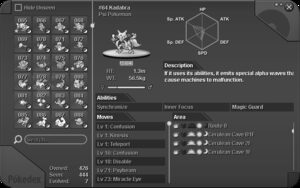| This article has been identified as a stub; its content needs to be either furtherly developed, rewritten, or updated. Read the discussion page for possible information, regardingly. You can help Pokemon Revolution Online Wiki by expanding it. |

An overview of the Pokédex’s in-game interface.
The Pokédex is a technological device that collects and stores Pokémon data. It computes a semi-encyclopedic breadth of data for Pokémon that you have registered data entries for.
The item is obtained nearly in the immediacy of a player’s travel; Professor Oak will bequeath it to the player after selecting their starter Pokémon in his lab, which will auto-register the caught-data entry of the selectee thereof despite how it antecedes the acquisition of the item itself. Because this device has conglomerative coverage overall Pokémon that are currently databased within Pokémon Revolution Online, this is the only one obtained throughout the game.
Pokédex-data entries are invaluable not just as an informatory tool for all Pokédex data; they also constitute some of the loftier requirements for in-game content, since many require a multimodal collection of seen-, caught-, and evolved-data entries in order to qualify for an area’s accessibility, quest progressivity and/or completion, and other covetable rewards.
Registering Pokémon-data entries
Pokédex-data entries can be subsumed into three modal categories: caught (owned, as nomenclature on the Pokédex itself), seen, and evolved.
While not all caught-data entries are attainable—much of which is attributable to limited obtainability of Legendary Pokémon and post-generational Pokémon that currently do not have their generationally respective region to indigenously inhabit—all seen-data entries are registrable up to the Generation III subset of Pokémon.
Seen-data entries
Seen-data entries are registrable simply by encountering the Pokémon in a battle regardless of whether or not you obtain it; this includes encounters with them in NPC-trainer and PvP battles. Additionally, interactions with most overworld-interactable will register seen-data entries, thereby greatening the ubiquity of their obtainability.
A Pokémon’s seen-data entry is the only Pokédex-data threshold needed to access all of its available data pertaining to the Pokémon.
Evolved-data entries
Evolved data entries are registered by evolving the Pokémon within your own custody. Evolved data entries of Pokémon will be markedly shown in the Pokédex, where the evolvees are emblematized by golden stars.
The evolution must be custodial in nature in order for it to register; evolved forms of Pokémon that evolved under the possession of another trainer or were caught in the wild will not register their evolved-data entries in your Pokédex. Because of these mechanical limitations, it is processually recommended that when trade-evolving Pokémon, you request the transactional intermediary to decline on the evolutionary prompt when it is initially traded to them; that way, when they trade it back to you, you will be prompted to evolve the Pokémon, yourself, thereby clinching its evolved-data entry.
Evolving a Pokémon will automatically register its caught- and seen-data entries for that evolve.
Caught-data entries
Caught-data entries are registered whenever the Pokémon lands under your ownership; this is predominantly done by capturing the Pokémon in the wild, obtaining it by evolutionary extension of another Pokémon, trading for it, or obtaining it from an NPC (typically as a reward). Obtaining caught-data entries automatically registers the seen-data entry of the species, more obviously.
All Pokémon that are registered in the Pokédex will be superimposed by an emblematic Pokéball in the Pokédex index.
Pokédex data

Obtaining the Pokédex in Oak’s Lab in Pallet Town.
Upon procuring a Pokémon’s seen-data entry, you will have access to the entire gamut of Pokédex data; that includes all moves that it learns via level-up and instinction, wild-spawn data, a descriptive writeup of the Pokémon species, and species-specific individualities. Because all data therein is referenced directly from the database, it is considered the most epistemically dependable informational resource in-game, consistently staying abreast of database changes that may alter it.
It provides the most informative Pokémon-locator out of any informatory tools in-game. Spawn data will only fall in the purview of those that were obtained in the wild—namely on land and in water (both by fishing and surfing); this does not include wild-Pokémon battles that were initiated by NPC script work, such as diggable patches or Headbutt trees, nor would that data be computable for it.
Pokédex-data requirements
Various content outlets will require accruals of Pokédex-data entries in order for features to be accessible; the most common necessitators include quests, access to supplementary areas, reward thresholds, and so forth. See the tabular list below for comprehensive information, pertaining.
Some requirements will stipulate generation-specific accruals of data entries; for example, if 100 caught-data entries were wanted for Generation I Pokémon, it would only count data-entries from that generational bracket. For generation-specific information on Pokédex-data entries, you can speak to the professors in the lab of the generationally respective region; they will inform you on how many caught- and seen-data entries you have from it.
|
||||||||||||||||||||||||||||||||||||||||||||||||
| All data-entry requirements that are parenthesized with roman-numeral notations of the generation require that the data entries strictly pertain to Pokémon of that generational subset. |